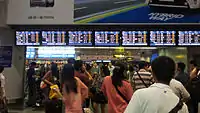July 2012 Beijing flood
In a twenty-hour period on July 21, 2012, a flash flood hit the city of Beijing in the People's Republic of China. Within a day of the flooding, 56,933 people had been evacuated, while the floodwaters killed 79 people,[1] causing at least 10 billion Yuan (US$1.6 billion) in damages and destroying at least 8,200 homes.[2] In the city, more than 1.6 million people were affected by the flood overall.[3]
 Flights delayed in Beijing Capital International Airport, Terminal 2 | |
| Date | July 21, 2012 (CST) |
|---|---|
| Location | |
| Deaths | 77+ (26 flooded) |
| Property damage | $1.6 billion USD |
Fangshan District was the most heavily affected area of Beijing, located in the southwest, which received a record-setting 460 mm (18 in) of rain, while on average the city received 170 mm (6.7 in) during the same period, the highest recorded since 1951. The Juma River flooded its banks and reached a flow rate of 2,500 m3 (88,000 cu ft) per second. A woman in Fangshan reported the river rose 1.3 metres on her home in approximately ten minutes.[4]
At Beijing Capital International Airport, the floods resulted in the cancellation of over 500 flights, stranding 80,000 travellers.[5]
Recent urban flooding in China
Urban flooding has recently become more frequent and severe in China. The main causes of the increase in flooding are the limited capacity of urban drainage networks, a loss of natural water bodies, and the loss of land during the urbanization of China.[6] The flooding in Beijing resulted from these factors as well as the heaviest rainfall to hit Beijing in 60 years.[7]
The 2012 flash flood was part of a series of flooding events across China that began in late spring of 2012 and continued during the summer. In July, the areas of southwestern China, including Guangxi Zhuang Autonomous Region, and northeastern China including Beijing, Hubei and Liaoning were worst-affected.
In 2011, a thunderstorm flooded Beijing and inundated Tiananmen Square. In 2007, a similar July thunderstorm claimed the lives of 22 people.[8] The 2012 flash floods reached levels not seen in previous years.[7]
See also
References
- "79 People Killed in the Flood" (in Chinese). People's Daily Online. August 6, 2012. Archived from the original on November 9, 2012. Retrieved August 12, 2012.
- Huang, Carol (July 25, 2012). "Beijing floods caused 'significant losses': official". Agence Presse-France. Retrieved 25 July 2012.
- Morning Post, Beijing (July 25, 2012). "北京官方未公布暴雨最新伤亡情况 ("Beijing Officials Have Yet to Release Latest Flood CasualtData")". EasyWeb News (163.com) (in Chinese). Retrieved 25 July 2012.
- Hu, Yongqi; Cui Jia (July 23, 2012). "Capital flood death toll hits 37". China Daily. Retrieved 23 July 2012.
- Chin, Josh (July 22, 2012). "Deadly Beijing Floods Spark Anger, Questions". The Wall Street Journal. Retrieved 23 July 2012.
- Zheng, Zheng (2016). "Urban Flooding In China: Main Causes And Policy Recommendations". Hydrological Processes. 30: 1149–1152. Bibcode:2016HyPr...30.1149Z. doi:10.1002/hyp.10717.
- "Beijing chaos after record floods in Chinese capital". BBC News. 2012-07-23. Retrieved 2016-11-22.
- Xu, Nan (25 July 2012). "Beijing floods: not enough prevention". The Guardian. Retrieved 25 July 2012.